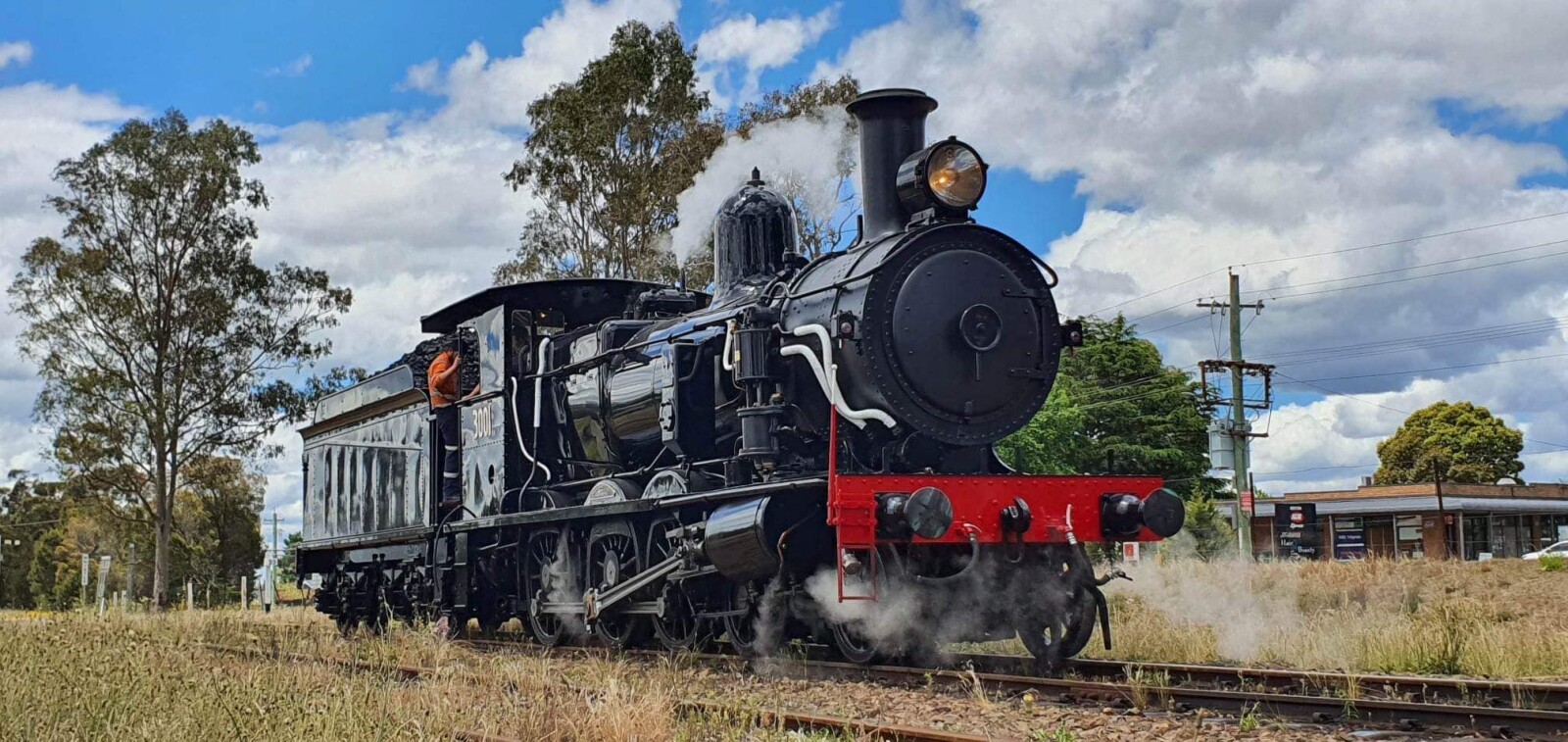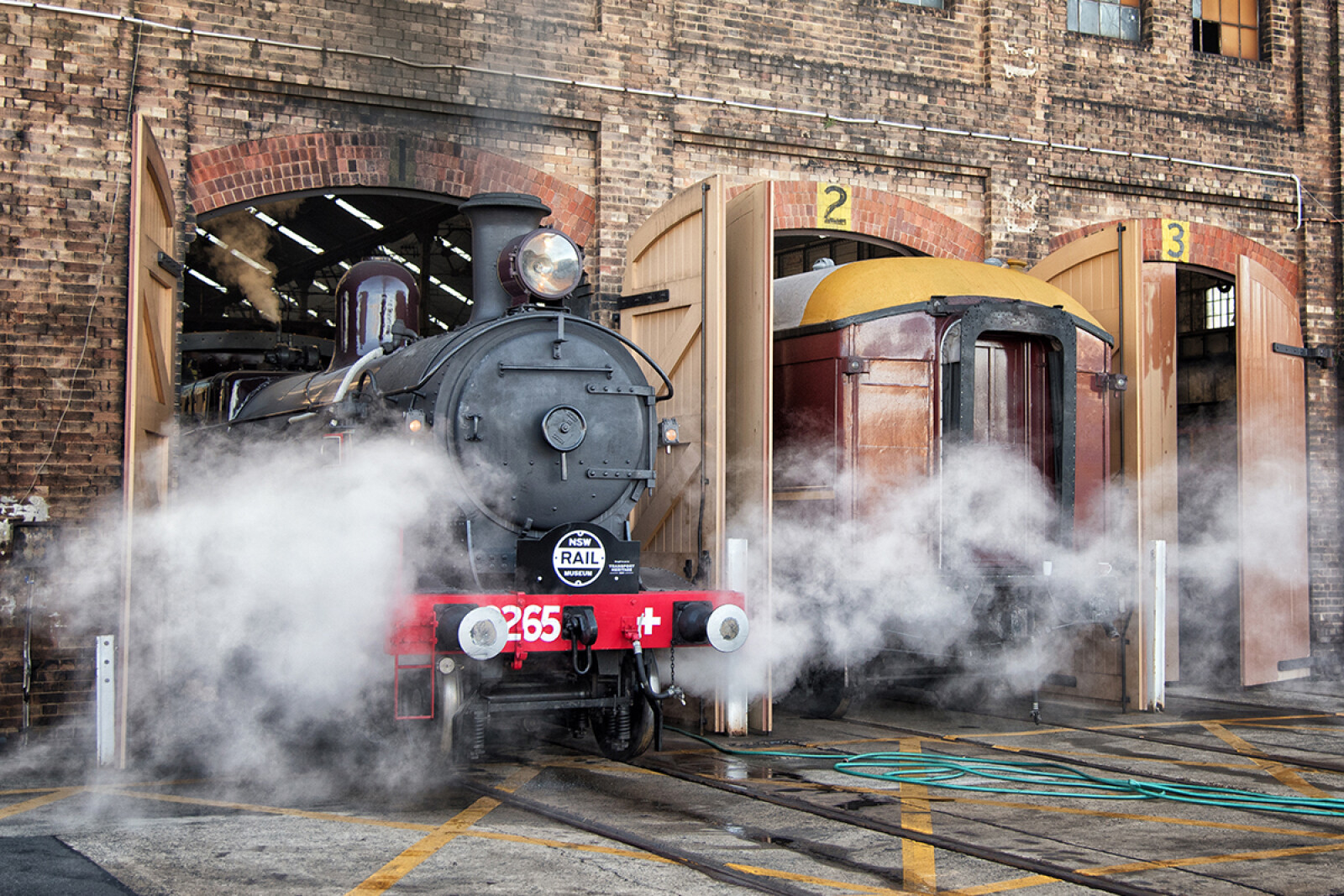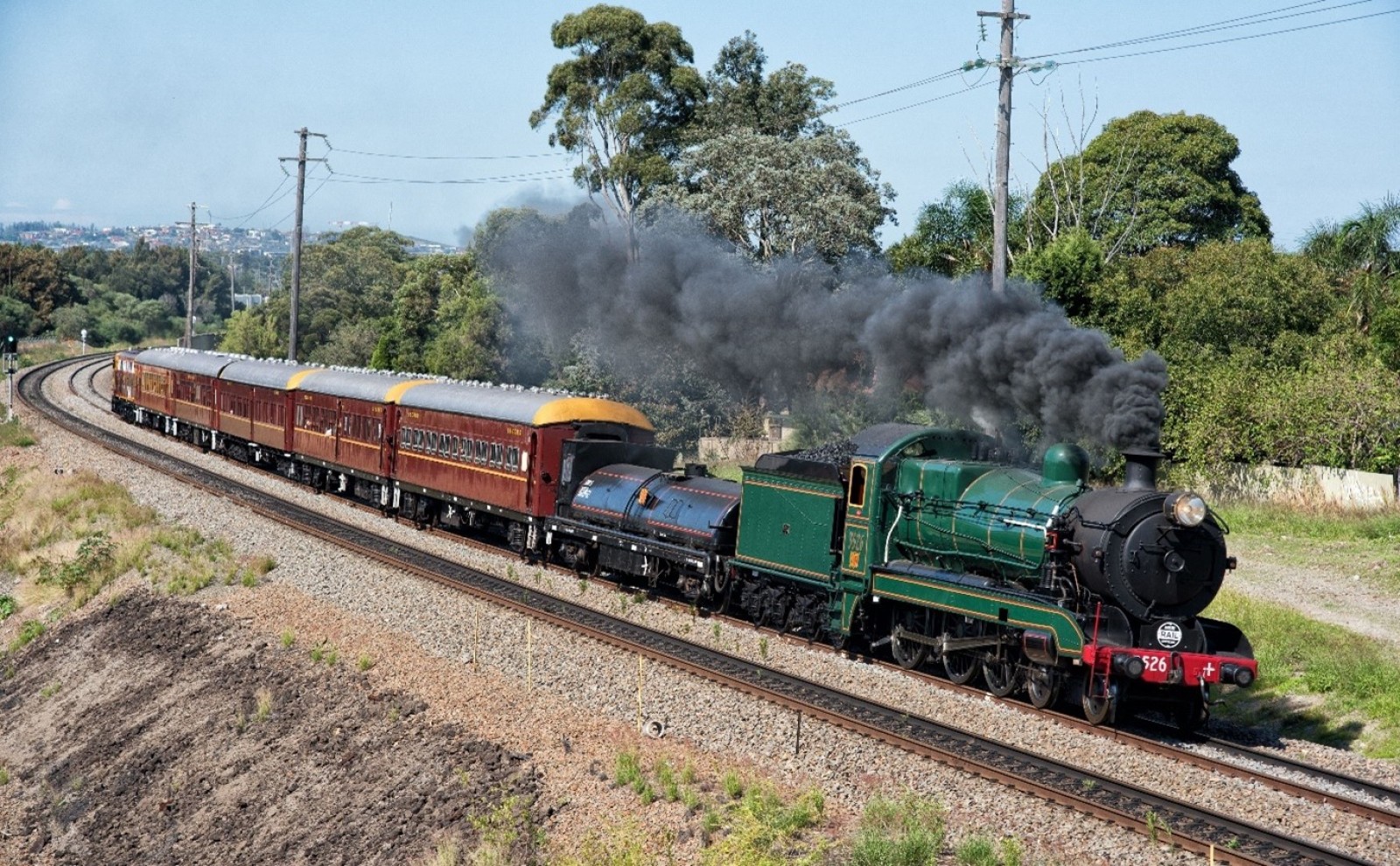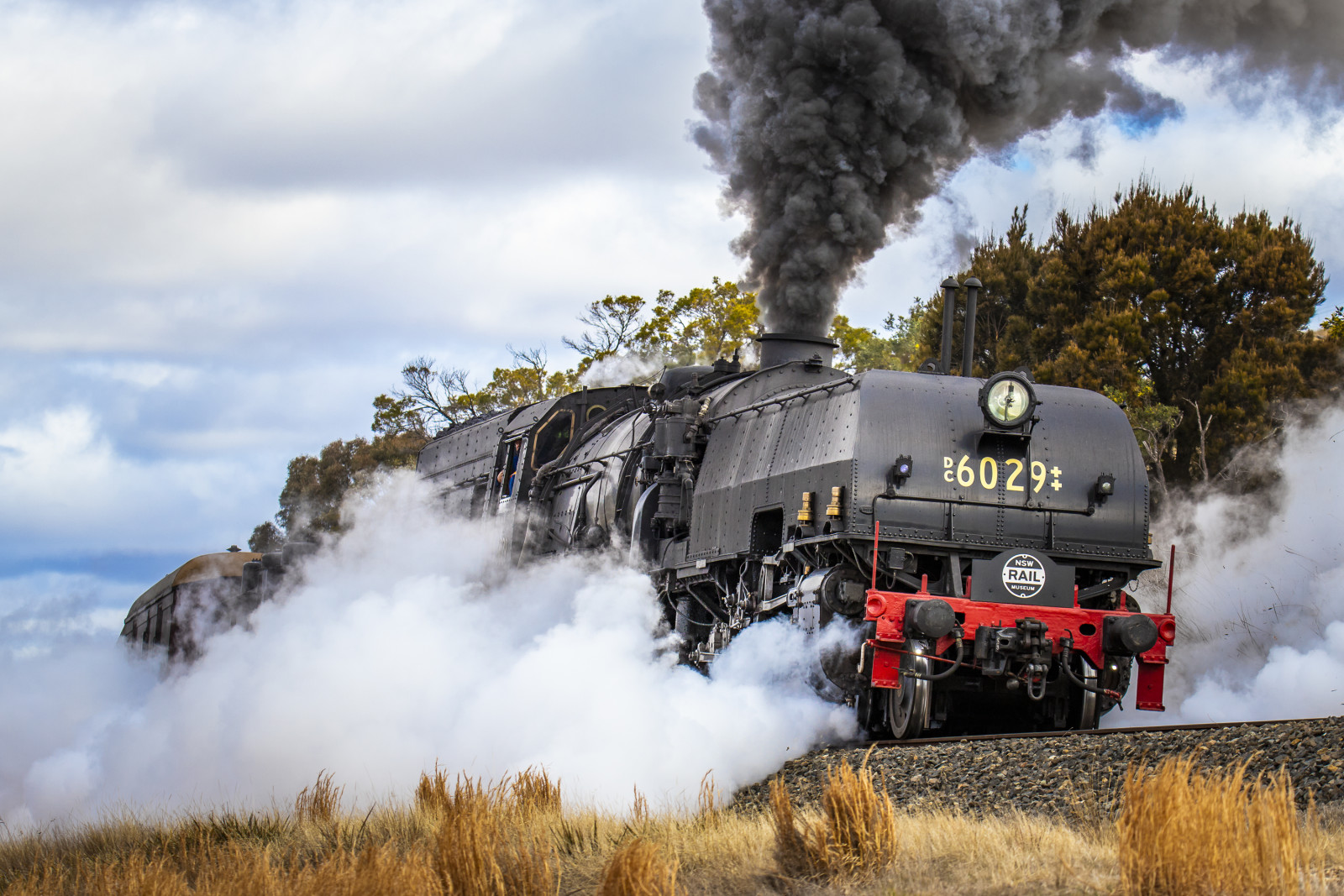From 120-year-old suburban locomotive 3001 to the Southern Hemisphere’s largest operating steam locomotive Beyer-Garratt 6029, visitors will be spoilt for choice with the biggest display of historic NSW railway steam engines at this year’s Thirlmere Festival of Steam.
All locomotives listed will either feature on display in steam or operate one of the many steam train rides throughout the weekend along the historic Loop Line.
Their will also be a range of smaller steam traction engines in and around the NSW Rail Museum throughout the weekend.
Please note: locomotives on display and in operation are subject to change without notice.
Locomotive 3001
Locomotive 3001 began life in 1903 as S 636, the first of 145 engines in the S class (later C30 class) 4-6-4 suburban tank locomotives. They were built by Beyer, Peacock and Co. in Manchester, UK. 3001 received its new number in 1924. After electrification of Sydney’s suburban railways from 1926, the career path of 3001 took a new course.
3001 was one of 77 C30 class tanks rebuilt as 4-6-0 tender locomotives between 1928 and 1933. The newly converted engines were reclassified as C30T, and 3001 was one of the last to be rebuilt.
Redeployed into rural service, the rebuilt engines were just as successful in the bush as they had been in Sydney’s suburbs. The class were modernised during World War II by being fitted with superheaters. These reheat steam, giving it greater energy and allowing it to perform more work, and they improved the economy of each engine by around 10 per cent.
For many years, until as late as 1967, 3001 was a regular performer on the Mudgee Mail four days a week between Mudgee and Gwabegar.
The C30Ts were so good at their ‘jobs’, that some survived in service until 1972.
3001 remained a working locomotive in heritage service until 1996. It has recently undergone a three-year restoration and will form part of THNSW’s operational heritage train fleet from March 2023.

Locomotive 3265
Locomotive 3265 entered service as 4-6-0 express passenger engine P 584 in 1902. It was renumbered 3265 in 1924 and was equipped with superheating in 1933. The 32 class became known as the "English express locomotives” due to their origin, although some were built in the USA by Baldwin and others in Australia. 3265 was among those built by Beyer, Peacock and Co. in Manchester, UK.
The 32 class hauled a range of passenger services on almost every line in NSW. With 191 members the class were among the NSW Railways’ most successful steam locomotive designs.
3265’s original livery was black, but in 1933 it was painted maroon and received the nameplate ‘Hunter’, to haul the Northern Commercial Limited express to Newcastle. The 32 class were soon replaced by larger locomotives on this run.
From around 1960 they were gradually replaced by diesel locomotives, mostly 48 class, but so functional were the class that the last regular steam-hauled passenger train in New South Wales was hauled by a 32 class engine from Newcastle to Singleton in 1971. These locomotives thus outlived their successors – the 35, 36 and 38 classes.
3265 ran for 66 years across NSW and was retired in 1968 after clocking 2,965,840km of service. It still has its original frame, and the cab is stamped with its builder's number.
Restored by the Powerhouse Museum in 2009, 3265 later received further mechanical repairs with Transport Heritage NSW and returned to service in 2019.

Locomotive 3526
Reclassified as the 35 class during the 1924 renumbering program, these locomotives were originally known as the NN class, which gave rise to the nickname ‘Nanny’. Built in 1917, 3526’s original number was 1314.
The 35 class 4-6-0 locomotives were built by the NSW Government Railways (NSWGR) at their workshops at Eveleigh. Coincidentally, there were 35 engines in the 35 class. They were intended to reduce the amount of 'double-heading' required for main line express trains following the introduction of heavy, twelve-wheeled corridor compartment cars.
Teething problems with the new design were overcome by several modifications throughout their service (including re-framing and re-balancing the driving wheels), seeing them develop into solid performers. The original cabs were replaced to provide the crew greater protection against the weather.
With the advent of the 36 and later the 38 classes, the 35s spent the greater part of their lives on northern services.
Withdrawn in 1967, locomotive 3526 in that year became the first exhibit to be painted by the NSW Rail Transport Museum, forerunner of Transport Heritage NSW. 3526 is one of the few NSW locomotives to have been painted in blue livery for a time, while hauling the Caves Express services from Sydney to Mount Victoria in the 1930s. Following a major overhaul completed in 2018, it now appears in Brunswick Green livery with red and yellow trim.
Locomotive 3526 will be available for cab visits at the NSW Rail Museum forecourt.

Locomotive 6029
With a length of 33 metres, 32 wheels and weighing 264 tonnes, 6029 is the largest operating locomotive in the southern hemisphere.
The 60 class engines adopted a concept developed by H. W. Garratt, whereby the boiler and driver’s cab is in the centre of the locomotive and there are two separate sets of wheels and motion, one at each end. The front engine unit carries a water tank, and a rear engine unit carries the coal bunker and another water tank. The weight of the locomotive is thus spread over many axles. For New South Wales, this meant that these engines could haul longer and heavy trains on lightly-built country lines.
The last steam locomotives introduced into NSW, the 60 class were manufactured by Beyer, Peacock and Co. in Manchester UK. The first of the class did not enter service until 1952. The original order for 25 locomotives was later increased to 50; but a change of mind as the advantages of diesels were recognised, meant that only 42 locomotives were delivered with a further 5 supplied unassembled, for use as spares.
The lack of turning facilities in country areas – the 60 class needed longer turntables, or triangles – meant that by far the greatest use of these locomotives was on main lines. Even then the few turntables on the system with the capacity to turn them, meant that they often ran in reverse. From 1958, a number of them, including 6029, were fitted with a second set of controls to allow the driver to face the direction of travel when travelling ‘bunker first’, denoted by DC - for dual controls - painted on the buffer beam. These locomotives also had their axle load increased to improve their tractive effort.
In their main line, heavy haulage roles the 60 class were a considerable success. They were the very last steam locomotives to run in regular operation on the NSW Government Railways; the last of the 60 class ended their service in the Newcastle area early in 1973. They had outlived the first of their successors, the 40 class diesels.
Locomotive 6029 entered service in April 1954, and received its dual controls in February 1959. It was withdrawn in 1972 having travelled just under a million kilometres during its working life. It was returned to service by the Australian Railway Historical Society (ACT Division) in 2015 and first appeared at the Thirlmere Festival of Steam to a record-breaking crowd in that year. In 2022 it was acquired for the state collection, the first purchase of a steam engine by the NSW Government for more than 60 years.

1064 Coal Grab CranE
1064 is a four-wheel self-propelled vertical-boiler coal grab, designed for coaling steam locomotives in smaller country locomotive depots which lacked more formal locomotive servicing facilities. It was constructed by the Austral Otis Engineering Company at their Alfred Harman Works, Port Melbourne in 1918 as one of a batch of four coal grabs and entered service as LO 39 with the NSWGR in August 1918. It was renumbered 1064 in the X10 class in the NSWGR's 1924 renumbering.
1064 finished its career with the NSWGR in June 1971 when it was withdrawn from Eveleigh Depot. It was transferred to the NSW Rail Transport Museum (now Transport Heritage NSW) in working order; however, it was later dismantled for rail transport to the (then) new museum at Thirlmere in 1975.
The boiler has recently been overhauled to enable 1064’s return to the Festival of Steam for the first time in many years.
The reassembly and repair of this machine after years of open storage is a great example of the high-quality restoration capabilities of the volunteers and staff at Transport Heritage NSW.
Contact
For all NSW Rail Museum related enquiries, including steam train rides, call 1300 11 55 99.